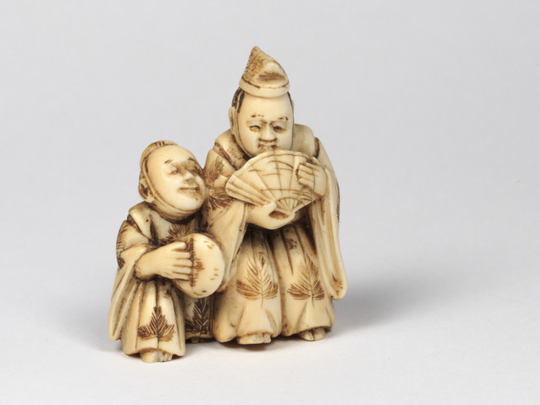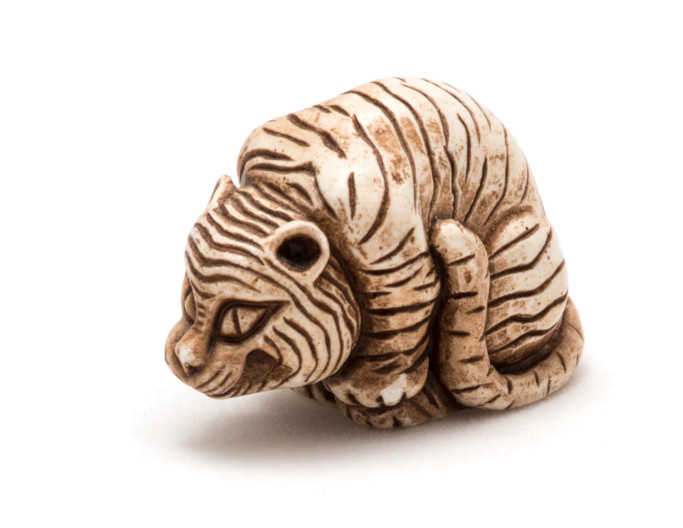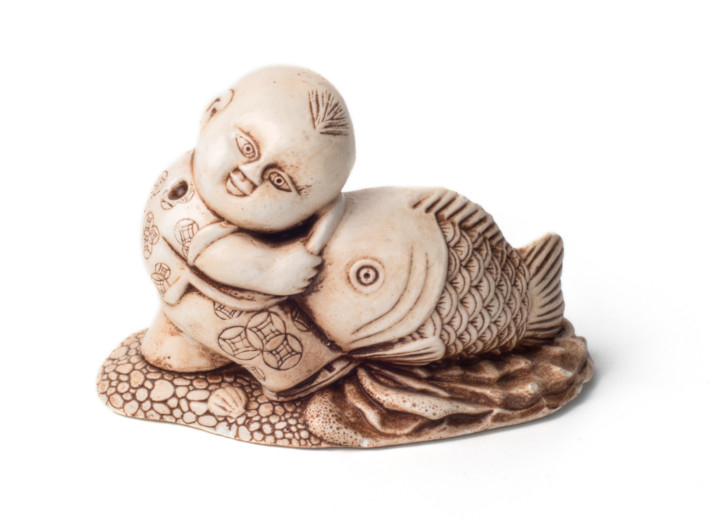
LONDON - In his award-winning biography, “The Hare With Amber Eyes,” British ceramic artist Edmund de Waal tells the story of his family through its collection of Japanese netsuke carvings.
Netsuke are ornamental toggles made mainly out of ivory or wood and used to fasten things to the sash of a kimono. Each one is “a small, tough explosion of exactitude,” as de Waal memorably wrote. Charles Ephrussi, a cousin of the author’s great-grandfather, bought a complete collection of 264 of these carvings from a Paris dealer in the late 19th century. Among them was an ivory netsuke of a trembling hare with amber-inlaid eyes.
Extraordinarily, the entire collection has remained intact, surviving World War II in Vienna, hidden in the mattress of a family servant. It spent further years in the apartment of an uncle in Tokyo, before being bequeathed to de Waal, who keeps it in his London home.
He writes in his book how a disapproving neighbour, surprised by the sight of such a precious object in a private house, suggested that the netsuke should be returned to Japan. “No,” replied de Waal. “Objects have always been carried, sold, bartered, stolen, retrieved and lost,” he said. “It is how you tell the stories that matters.”
Such stories of lives lived through material culture could be severely curtailed here in Britain, following the government’s announcement this month that it will be banning the sale of items made with ivory. The measure is designed to protect elephants, the Department for Environment, Food & Rural Affairs said. It is not clear when the legislation would be brought before Parliament.
The department said that 20,000 elephants were killed for their ivory in 2017. Last year, China pledged to shut down its commercial trade in the material.
After consultation, the Conservative government has modified its 2015 pre-election pledge to implement a total ban on ivory sales. The proposed legislation has, nonetheless, thrown the British antiques industry into a spin.
“We can trade at the top end, but for someone starting out or people in the middle market, this is a total disaster,” said Jan Finch, partner at Finch & Co., a London-based dealership specialising in unusual objects from around the world. Ivory pieces frequently appear in its stock.
Like many in the British art and antiques trade, Finch thinks the 10 percent maximum for ivory-decorated antiques is too low and would like to know how the criterion “rarest and most important” will, in practice, be applied.
“A whole load of stuff will be illegal,” Finch added, referring to everyday items such as boxes and chess sets that will soon be unsellable and unexportable.
But where, exactly, will the “top end” of the remaining trade in antique ivory be pitched? How many of those relatively humble Japanese netsuke carvings, for example, will pass the “rarest and most important” test?
The Animal and Plant Health Agency “could decide to establish a bar that’s too high,” said Max Rutherston, a leading specialist dealer in netsuke, who is based in London. “If I’m offered a great piece, how do I know it’s going to get a sales permit?”
Rutherston has 155 ivory netsukes in stock, 130 of which are being offered on behalf of clients. Prices range from about 250 pounds, or about $350, to 45,000 pounds, the level at which he currently values de Waal’s “Hare With Amber Eyes.”
Uncertain of how much of his stock will be eligible for government-issued sales permits, Rutherston said he is considering relocating his business to continental Europe, perhaps to the Netherlands.
In Britain, the window for buying and selling antique ivory is closing.
Is this the death of ivory antiques?
“We are turning things away,” said Lee Young, managing director of Duke’s, an auction house in Dorchester, England. “We’re not going to be able sell something that could be worthless in six months’ time.”
Young, a specialist in Asian art, said there could well come a point when Duke’s, along with other British-based auction houses, would no longer sell ivory.
“The trade will die because people will be too embarrassed to own these things,” Young said. But what will happen to the mountain of unsellable, unexportable ivory antiques that will then accumulate in Britain? “You’ll only be able to pass it down the generations, and they won’t want it,” he added.
The “Hare With Amber Eyes,” a signed piece by Osaka carver Masatoshi, dating from around 1880, would doubtless pass Britain’s “rarest and most important” test, thanks to the success of de Waal’s book. But what about all the other, less exceptional ivory netsuke in this family collection? When Britain’s ban on its ivory trade becomes law, these too could become unsellable and, in a sense, worthless.
If - and in dealers’ minds, this remains a huge “if” - elephants can be saved by banning the trade in antique ivory, this would be a story with a happy ending. But a lot of other stories will be lost along the way.
What’s the scene in..
... Europe?
Dealers in the European Union, who can trade in worked ivory dating from before 1947, courtesy of an exemption in the Convention on International Trade in Endangered Species of Wild Fauna and Flora, also have problems with this controversial stock-in-trade.
“It’s much more difficult to sell ivory,” said Florian Eitle-Bohler, director of the old master sculpture dealers Julius Bohler Kunsthandlung, based in Starnberg, Germany. “I’ve reduced prices by about 50 per cent in the last five years,” said Eitle-Bohler, who exhibited an exceptional pair of 17th-century ivory reliefs, “Bathsheba at Her Bath” and “Lot and His Daughters,” attributed to Francis van Bossuit, at last month’s Tefaf fair in Maastricht, Netherlands, priced at 250,000 euros, or around $310,000. He said his gallery did not sell any ivory pieces at the fair.
Eitle-Bohler, echoing other British and European dealers, said one of the main problems was the ending of the trans-Atlantic trade in ivory. “You can’t sell to America,” he said. “You commit a felony. It gets destroyed.”
... in New York
New York’s status as a no-go zone for trading in antique ivory is being challenged by dealers in the US. In a complaint filed on April 5 to the U.S. District Court for the Southern District of New York, the Art and Antique Dealers League of America and the National Art and Antiques Dealers Association of America are contesting the New York state law passed in 2014 banning the sale of antique ivory.
There will be examptions
Like the United States, which in 2016 announced a near-total ban on the trade of African elephant ivory, Britain will have some exemptions. These will require permits, available for a fee from the government’s Animal and Plant Health Agency.
It will be possible to trade items containing less than 10 percent ivory, provided they were made before 1947.
The same applies to musical instruments with less than 20 percent ivory, made before 1975, and to portrait miniatures on ivory more than 100 years old.
Exemptions will also apply - and this is the proposed legislation’s grayest area - to the “rarest and most important items of their type,” if they are at least 100 years old. Again, these items will have to be registered with the Animal and Plant Health Agency, which will then seek advice from a museum on whether to issue a permit for sale.
















